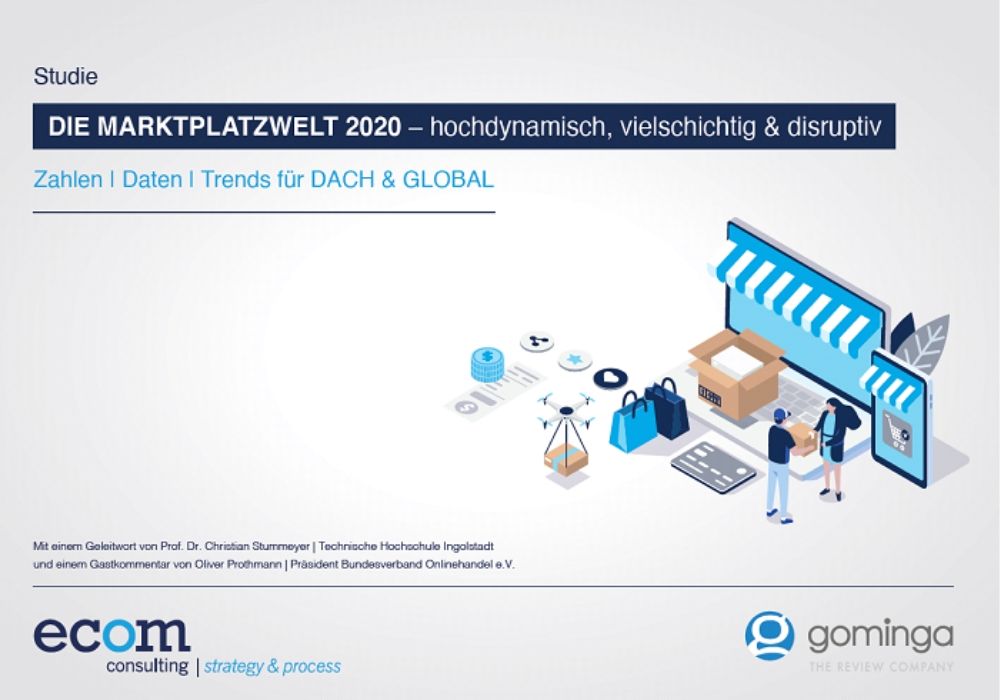MANAGEMENT SUMMARY
- More than 480 marketplaces globally, with 37% having a shop in the German speaking area (GSA)
- Number of active marketplaces has more than doubled in GSA from 2015 to 2020
- Marketplaces total up to or more than 50% of total ecommerce volume depending on geography, with above-average growth rates in many countries
- 30% of marketplaces not only offer the technology platform with adjacent services but sell their own stock as well, meaning the marketplaces are in competition with the manufacturers or retailers selling on their marketplaces
- About 50% of GSA and global marketplaces are generalists in terms of product assortment. Fashion & lifestyle is the largest industry-specific segment, followed by consumer electronics and home & living
- B2C marketplaces are clearly in the lead but the number B2B players is growing rapidly. New formats such as social & content commerce are also on the rise
- Many new marketplaces have started within the past 5 years, with some of them ceasing existence already. Consolidation in the market is still to happen
- Amazon is still second to none when it comes to traffic and marketplace services (at least outside Asia). However, there is still room for players with products or services that do not fit into the “Amazon machine”. For example, fashion, food, or the new formats such as social commerce
- Topics like social commerce or user generated content are vitally important for marketplaces and all their participants. Product reviews, product questions and seller reviews have not only established the community notion within the ecommerce space but also enable manufacturers, brands, and retailers to get direct consumer feedback and interact with them. In combination with AI, this brings completely new possibilities regarding market research and customer centricity
- We believe the industry will continue to innovate and change rapidly. Question is which trends from Asia will be successful throughout the world and if Europe can create a true tech leader anytime soon
“Online marketplaces keep business, politics and media busy. After all, the incumbents of the international retail industry, including Argos, Best Buy, Carrefour, Galaries Lafayette, METRO and Walmart have placed their future in the hands of the marketplace model.” – Ralph Hübner, Partner of ecom consulting GmbH
TOP 10 FINDINGS
Finding 1
Exponential growth with many new players: The marketplace landscapes illustrate the enormous number of marketplaces, which all compete for traffic and sellers (manufacturers, brands and retailers) alike. On a global level, we have more than 480 individual players.
When counting country stores such as amazon.de, amazon.co.uk, amazon.com etc. individually, then the total number of marketplaces is well above 900.
This shows the difficulty every CEO faces: which is the right marketplace for us? How should we prioritize our resources?
Finding 2
Marketplaces In A Risky Double Role: Globally and in the GSA region, 1/3 of all marketplaces not only offer the technology platform and adjacent services but sell their own goods on the marketplace. This means that they are directly competing with sellers on the platform, and thus creating antitrust related questions.
Finding 3
Ongoing Differentiation Of Marketplace Models: Due to the enormous growth of new players, various models have evolved. We have categorized the marketplaces into B2C, B2B, C2C, Social & Content Commerce and Price Comparison.
We are fully aware that there is not always a clear line to distinguish between one format and another, and many players are active in more than one field. This makes it even more complex for manufacturers and retailers to find the best partner in this jungle.
Finding 4
2015 Vs. 2020 – 2 Completely Different Pictures In GSA: While in 2015 only a handful of players such as Amazon and eBay made up the marketplace arena, today we see more than 170 companies in GSA competing for customers (and sellers).
1 of the 3 major reasons for this growth is that traditional retailers have now added their own marketplace platforms.
Finding 5
Consolidation Is Still To Come: Players come, players go. The recent marketplace mania will see not only new companies entering the playing field but also marketplaces to fail.
Especially in the B2C segment, one must question how many firms can co-exist and gain enough customer attention (i.e. traffic) to survive in the long run. Let alone the technical expertise and services needed to maintain a convincing value proposition for sellers.
Finding 6
Generalists And Specialists Keep The Balance: In GSA (44%) and globally (55%), generalists with a broad product offering mirror the “ancient” offline situation with large department stores.
Interestingly, this is similar in countries with major international players such as Amazon to those without, where local heroes are strong (e.g. Allegro in Poland, bol.com in The Netherlands, or Cdiscount in France).
Category killers are particularly successful in the fashion and DIY segments.
Finding 7
Product Reviews, The Secret Factor For Success: User Generated Content is crucial today, with seller and product reviews being the crucial trust factors in the marketplace world.
Product reviews have been one of the determinants for Amazon Retail becoming so successful and the Seattle leader is still testing and optimizing its review functionality today.
Only 40-45% of B2C-marketplaces give the customer a “voice” in terms of product reviews, which still leaves a lot of room for improvement.
Finding 8
Social And Content Commerce Conquer The Market: Advertising and content merge when consumers become influencer and interact with each other.
Add a buy button to social media channels and you get a new form of marketplace. Instagram, Pinterest and Snapchat are examples of this but China leads the way here with many new and innovative formats emerging.
Finding 9
Community-like communication between users and brands brings the good old store employee into the digital world. Many manufacturers and retailers still do not see the potential in this.
Finding 10
With up to 20 million visits per month in Germany, the likes of Idealo or Check24 compare prices and reviews in order to create transparency and trust for consumers.
Both price comparison sites and marketplaces benefit from the increasing share of affiliate advertising.





